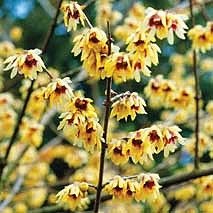
Garden News: Plant of The Month: Chimonanthus praecox
January, often dreary, is a time to retreat in front of the fire with the curtains closed and the central heating on. It is often a disappointing month in the gardening calendar too. However don’t beat yourself up about it too much, consider it a time for planning, in the warm, with a cup of tea and the fire warming your toes.Chimonanthus, otherwise known as Wintersweet, is grown chiefly for the wonderful scent produced by its insignificant, creamy-yellow, waxy flowers, borne on bare stems from about December to March. It is found growing wild at altitudes of 10,000ft among the mountain scrub of China and was introduced into this country in 1766.
Wintersweet has rough, opposite, dark green leaves and small, solitary, highly scented, yellowish flowers borne on short stalks in winter and spring before the leaves appear. The outer petals (tepals) are waxy, almost transparent in appearance, while the inner tepals are smaller and usually purplish. The flowers are beetle-pollinated.
Many parts of the plant are also rich in essential oils and are used for culinary and medicinal purposes. The flowers are used as a folk medicine in China for treating measles, coughs and tonsillitis. Its essential oils are used in cosmetics, perfumery and aromatherapy. The flowers are used to flavour herbal teas and are also added to potpourri mixtures. In China, wintersweet has long been used to scent linen, in much the same way lavender is used in the UK.
Named cultivars include Chimonanthus praecox ‘Luteus’, which has slightly larger flowers and yellow inner tepals, and C. praecox ‘Grandiflorus’, a larger shrub, with bigger leaves and larger, but less strongly scented, pure yellow flowers, with red-stained inner tepals. Both cultivars have been presented with an Award of Garden Merit by the Royal Horticultural Society.
Chimonanthus grows well in a sheltered position, particularly against a warm wall in full sun or in a sunny place on the edge of woodland in warm climates, in moist, but well-drained soil. It can be grown in most soils, but does best on chalky ones. It should only be pruned very lightly, immediately after flowering and is best grown from seed.
If placed close too or on a sunny wall, this shrub can act as a host to an early-flowering clematis, such as one from the alpina or macropetala groups, or a late-summer-flowering one, such as 'Hagley Hybrid' or 'Rouge Cardinal'. It's not the most attractive of shrubs later on in the season but planting something at its base like Geranium Patricia, which should scramble up into the lower branches of the wintersweet, will help to provide some summer colour and interest too.
While not the best shrub for summer, its sweet scent certainly encourage you out of the house and into the garden even on the coldest winters day.
Jobs to be done in January:
Ornamental Garden:
• Keep off the soil if the ground is waterlogged to avoid compaction and worsening the conditions.
• If snow falls – Don't let the snow sit on the shrubs, gently shake off to prevent damage.
• Prune bush or standard apples and pears, to create an open framework of 5 main branches.
• Sweet Peas can be sown this month and those sown in autumn can be potted on. Place in a sunny greenhouse, coldframe or windowsill.
• Plan annual cut flowers for the borders.
• Mulch borders if not already done in autumn.
• Plant deciduous hedges.
• Move deciduous trees and shrubs if necessary.
• Ensure protective coverings have remained in place over frost tender plants.
• Avoid walking on turf when the grass is covered with frost or is waterlogged.
Vegetable Garden:
• Protect brassicas from pigeons with cloches, netting or fleece.
• Harvest Winter Vegetables such as parsnip, swede, sprouts, leeks and turnip.
• Remove one third of oldest blackcurrant stems at ground level to encourage new basal shoots.

